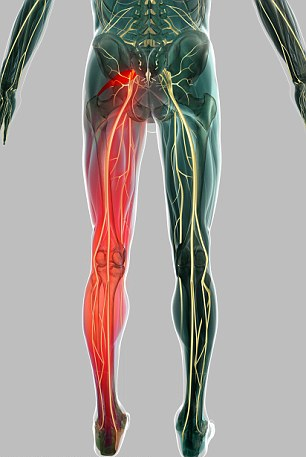Have Sciatic Pain or Discomfort?
Doctors of Chiropractic (DC) medicine regularly treat sciatica. Sciatica is characterized by pain that originates in the low back or buttock that travels into one or both legs. Sciatic nerve pain varies in intensity and frequency; minimal, moderate, severe and occasional, intermittent, frequent or constant.
Pain is described as dull, achy, sharp, toothache-like, pins and needles or similar to electric shocks. Other symptoms associated with sciatica include burning, numbness and tingling sensations. Sciatica is also called radiating or referred pain, neuropathy, or neuralgia. A misconception is that sciatica is a disorder; however, sciatica is really a symptom of a disorder.
Sciatica Is Caused by Nerve Compression 
Sciatica is generally caused by sciatic nerve compression. Disorders known to cause sciatic nerve pain include lumbar spine subluxations (misaligned vertebral body/ies), herniated or bulging discs (slipped discs), pregnancy and childbirth, tumors, and non-spinal disorders such as diabetes, constipation, or sitting on one's back pocket wallet.
One common cause of sciatica is piriformis syndrome. Piriformis syndrome is named after the piriformis muscle. The piriformis muscle is located in the lower part of the spine, connects to the thighbone, and assists in hip rotation. The sciatic nerve runs beneath the piriformis muscle. This muscle is susceptible to injury from a slip and fall, hip arthritis, or a difference in leg length. Such situations can cause cramping and spasm to develop in the piriformis muscle, thereby pinching the sciatic nerve and causing inflammation and pain.
Sciatic nerve compression may result in the loss of feeling (sensory loss), paralysis of a single limb or group of muscles (monoplegia), and insomnia.
Proper Diagnosis of Sciatica Is Essential
Since there are many disorders that cause sciatica, the chiropractor's first step is to determine what is causing the patient's sciatica. Forming a diagnosis involves a thoughtful review of the patient's medical history, and a physical and neurological examination.
Diagnostic testing includes an x-ray, thermography scan, and a 3-point analysis scan of your feet. These examinations and tests help to detect possible contraindications to spinal adjustments and other chiropractic therapies.
Chiropractic Treatment of Sciatic Symptoms
The purpose of chiropractic treatment is to help the body's potential to heal itself. It is based on the scientific principle that restricted spinal movement leads to pain and reduced function and performance. Chiropractic care is non-invasive (non-surgical) and drug-free.
The type of chiropractic therapy provided depends on the cause of the patient's sciatica. Below are more details on these chiropractic treatment modalities.
- Ice/Cold therapy reduces inflammation and helps to control sciatic pain.
- Adjustments (Spinal Manipulation) At the core of chiropractic care are spinal adjustments. Manipulation frees restricted movement of the spine and helps to restore misaligned vertebral bodies to their proper position in the spinal column. Spinal adjustment helps to reduce nerve irritability responsible for causing inflammation, muscle spasm, pain, and other symptoms related to sciatica. Adjustments should not be painful. Spinal manipulation is proven to be safe and effective.
In college and during their training, students of chiropractic learn many different adjustment techniques enabling them to treat several types of subluxations and disorders. Techniques vary from a swift high velocity thrust to those that combine minimal force and gentle pressure. Mastery of each technique is an art that requires great skill and precision. Spinal manipulation is the treatment that differentiates chiropractic care from other medical disciplines.
